Insulation Tips
Australia’s Best Underfloor Insulation in 2024
A lot of people overlook underfloor insulation but without it you could be losing or gaining as much as 20% of your home’s heat.
Whether you’re building a new home, renovating or looking for ways to improve energy efficiency, underfloor insulation is a great investment that can help you reap long term benefits.
Figuring out what’s the best underfloor insulation for your project can be tricky, so we’ve put together this guide on the best underfloor insulation products for Australian homes. Find out what products are on offer and how to maximise the benefits while sticking to budget.
What Is Underfloor Insulation and How Does It Work?
Underfloor Insulation, like insulation in other areas of the home, slows down the flow of heat. This helps prevent heat loss in winter and heat gain in summer. Insulation can also have acoustic benefits, reducing the transfer of unwanted noises throughout your home.
Houses that are properly insulated are better at regulating indoor temperatures and rely less on artificial heating and cooling. That’s how insulation can save you money on your energy bills year round.
ALSO READ – HOW DOES INSULATION WORK?
Factors to Consider When You’re Installing Underfloor Insulation
The most suitable underfloor insulation for your project depends on a number of factors such as:
- Retro-fitting vs installing in a new home. The underfloor space in existing houses tends to be less accessible which may affect which products and methods you use.
- Type of home and accessibility to the underfloor space. For example, suspended timber floors will require different insulating techniques to slab concrete floors.
- Local climate. Cold climates may require higher performance insulation whereas warm climates may benefit from reflective insulation.
- Building regulations. You must comply with regulations in the Building Code of Australia as well as any local building regulations.
- Underfloor vs mid-floor insulation. Insulating between floors of a multi-storey home has different requirements than underfloor insulation.
- DIY vs professional installation. Some types of underfloor insulation are easier to handle for DIY installations, while others require expert handling.
- Acoustic needs. Some insulation products can help manage noise transfer and acoustic quality in your home.
- Personal preferences and environmental concerns. Preferences for particular material types, brands and sustainability factors may affect your decision.
- Budget. Check out our guide to the cost of underfloor insulation in Australia to work out how much you’ll need to invest.
What Is the Best Type of Underfloor Insulation?
The most popular underfloor insulation products include polyester rolls, glasswool batts, XPS foam boards and rigid board insulation. Below we explain the features of each type and when to use them.
ALSO READ – CAN YOU USE WALL INSULATION UNDER FLOORS?
1. Polyester Rolls
Polyester rolls such as as Autex GreenStuf Underfloor Insulation and Bradford Polymax Underfloor Insulation are a type of bulk insulation. They work by trapping billions of tiny air pockets in their structure which slow down the transfer of heat.
Polyester rolls are made primarily out of recycled plastic materials, are pleasant to handle and contain no breathable fibres. They come in a range of brands, thicknesses and R-values. An affordable alternative to the Autex Greenstuf and Bradford Polymax products is our Polyester Underfloor Insulation Rolls.
If you pick a higher R-value or specialised acoustic product you will experience noticeable acoustic advantages on top of the thermal benefits.
Polyester rolls are ideal for suspended timber floors and other types of suspended floors where you can safely access the floor joists. The rolls are stapled between the joists to ensure they stay in place over time.
2. Glasswool Underfloor Insulation Batts
Glasswool batts are a type of bulk insulation which rely on billions of tiny air pockets to slow down heat flow. They can be used throughout the home in walls, ceilings and floors.
Glasswool products are a cost-effective option, made primarily from recycled glass materials. Insulation batts are pre-cut to fit between the joists of timber floors and can be strapped or stapled in place.
Options such as Knauf Earthwool Underfloor Insulation Batts are pleasant to handle with none of the itchiness traditionally associated with glasswool. Acoustic options can provide noticeable acoustic advantages by reducing reverberation within the home.
3. Extruded Polystyrene (XPS) Foam Boards
XPS foam board insulation has a dense closed cell structure which provides excellent thermal resistance. It can be used in a variety of applications throughout a home and is particularly effective in concrete floors as an under slab insulation.
XPS has high compressive strength and is water resistant, which means it can help prevent thermal loss through the ground. It can even be used in multiple layers for higher thermal resistance.
XPS insulation is typically installed before the concrete slab is poured. A good example of XPS Board is Foamex StyroTherm Insulation and Kingspan GreenGuard (now available at Pricewise!).
Contact us on 1300 729 639 or email sales@pricewise.com.au for custom pricing.
4. Expanded Polystyrene (EPS)
Expanded PolyStyrene (EPS) is a closed-cell, rigid foam material. EPS insulation is designed to create a thermal barrier and reduce heat loss from the slab.
EPS insulation is typically installed before the concrete slab is poured. A good example of EPS board is Slabmate by Foilboard Insulation.
5. Foilboard Insulation
Foilboard is a rigid insulation panel which can be used in walls and roofs as well as underfloors. They are made from a fire retardant expanded polystyrene core with a pure aluminium layer of foil on both sides. This provides a thermal break and vapour barrier for superior thermal performance and moisture resistance.
Foilboard insulation can be installed quickly and easily and is pleasant to handle as it has no fibres. Panels are easy to cut to fit between the timber joists of a floor and are held in place by floor saddles and joining tape. Foilboard Green is an excellent choice for this type of insulation.
Best Underfloor Insulation in Australia
Australia’s leading brands for underfloor insulation include:
- Knauf Earthwool Insulation
- Bradford Polymax Insulation
- Bradford Optimo Insulation
- Foilboard Insulation
- Kingspan Air-Cell Insulation
Best Underslab Insulation in Australia
Australia’s leading brands for underslab insulation include:
- Slabmate by Foilboard
- Foamex StyroTherm XPS Insulation
- Kingspan Kooltherm K3 Insulation
- Kingspan GreenGuard XPS Insulation (Contact Us for custom pricing)
What Is a Good R-value for Flooring?
The R-value of an insulation product tells you how well it resists heat flow. So a product with a higher value will have greater thermal properties than a product with a lower R-value.
For underfloor insulation, we recommend choosing quality products with an R-value of at least R2.0. Keep in mind, you may be subject to local building regulations when it comes to meeting minimum R-Values.
What’s the Best Insulation for Your Floor Type?
The type of floor you have will affect what products and methods you use to insulate it.
1. Suspended Floors
Many older homes are built with suspended floors. If the floor space can be accessed from underneath, you can install insulation batts or rolls between the floor joists and then staple (rolls) or strap (batts) them in place. Alternatively, foil-faced foam boards can be used for suspended floors.
If the crawl space is not accessible, it may be possible to insulate the floors by removing the existing flooring. Draught proofing your floors will also help reduce heat loss and gain.
2. Timber Floors
Suspended timber floors are typically insulated using insulation batts or rolls between the floor joists. In existing homes, this can be done from underneath if there is enough crawl space. Otherwise, you may be required to remove the floorboards in order to access the underfloor area. In new homes, insulation batts and rolls can be installed before the subfloor goes down. This is much easier than crawling under the floor when the house is finished, and is our recommended method!
When batts are installed touching timber floor boards, they can help reduce reverberation and absorb some floor sounds, making your floors sound more solid. For the best acoustic results, we recommend using a specialised acoustic product.
3. Suspended Concrete Floors
Suspended slab floors are concrete slabs that are not in contact with the ground. They are often used in homes that are built on hilly terrain.
Suspended slab floors can be insulated underneath using rigid foam boards or foil-backed rigid foam boards. Insulation batts such as Bradford Optimo Underfloor Batts can also be used on concrete slabs, however care should be taken to manage condensation and moisture issues.
4. Concrete Slabs on The Ground
Concrete slabs that are in contact with the ground are easiest to insulate during the building process. Your Home recommends insulating the sides of the concrete slab, especially if you live in a colder climate.
The underside of the slab should be insulated if groundwater is present. A vapour barrier and foam board can be used before the concrete is poured, while specialised foam boards may be used after the concrete is poured, depending on how much clearance you have.
Does Underfloor Insulation Make a Difference?
Properly installed underfloor insulation makes a significant difference to winter heat loss and summer heat gain in any home. Even if the rest of your home is insulated, the floors can let in air draughts or allow heat to leak out.
Reasons to invest in underfloor insulation include:
- Better regulation of indoor temperatures
- Savings of up to 10-20% on electricity bills
- Reduced electricity usage and environmental impact
- Acoustic benefits
To experience the maximum benefits of insulation, it’s important to insulate other areas of your home, not just under the floors. Check out our guides to the best insulation for other areas of your home:
- Best ceiling insulation for Australian homes
- Best insulation for your attic project
- Best roof insulation for your home
- Best acoustic insulation for soundproofing your home
- Choosing the right wall insulation
Need Help Choosing the Best Underfloor Insulation for Your Project?
If you need assistance choosing the ideal underfloor insulation products for your particular situation, get in touch with the team at Pricewise Insulation.
Browse our large range of high-quality underfloor insulation products, or call our team on 1300 729 639 for expert advice about your project.
Featured ProductsBrowse All



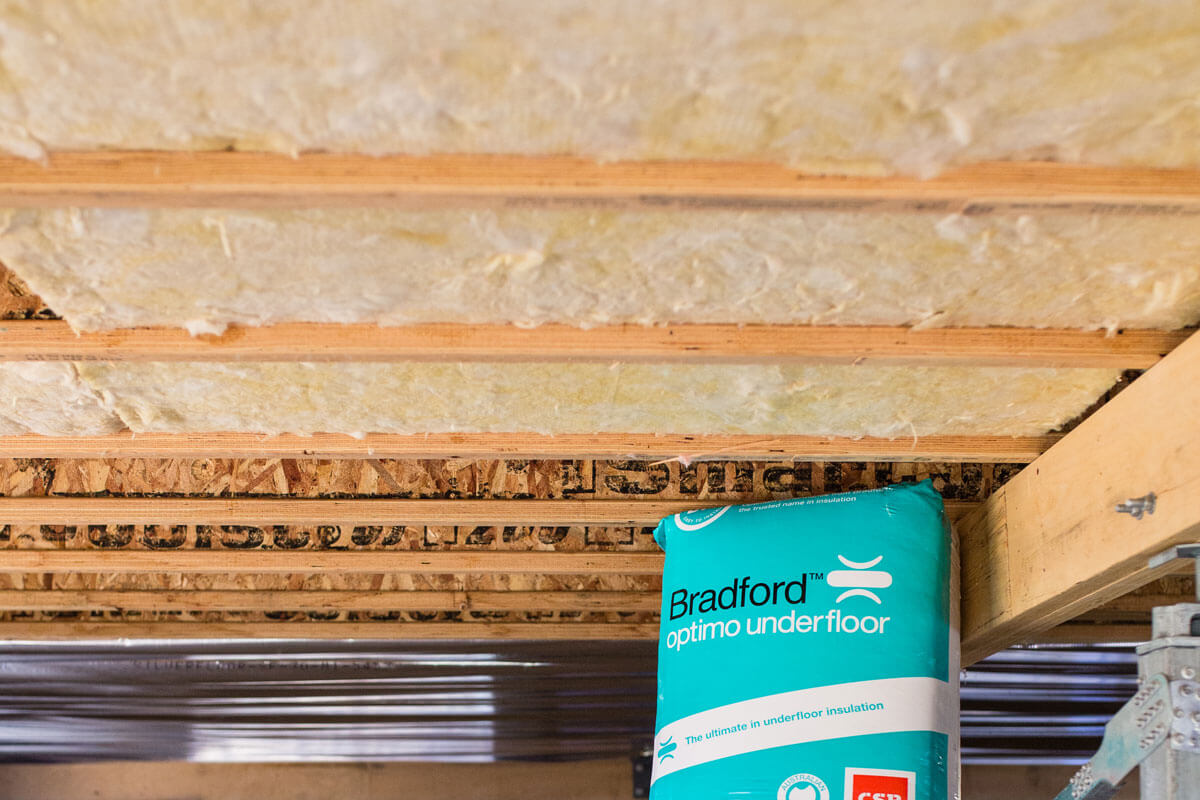
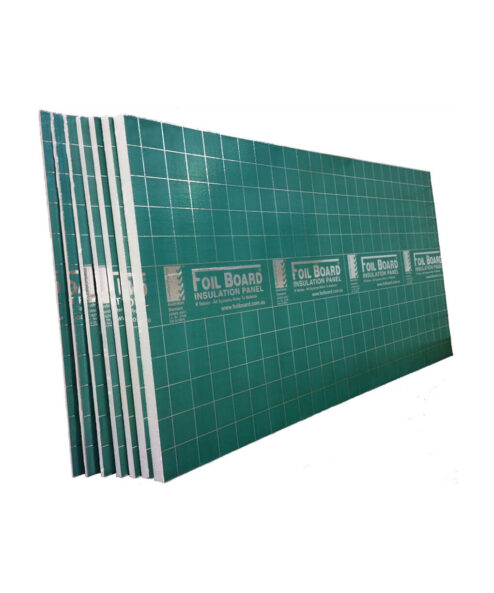
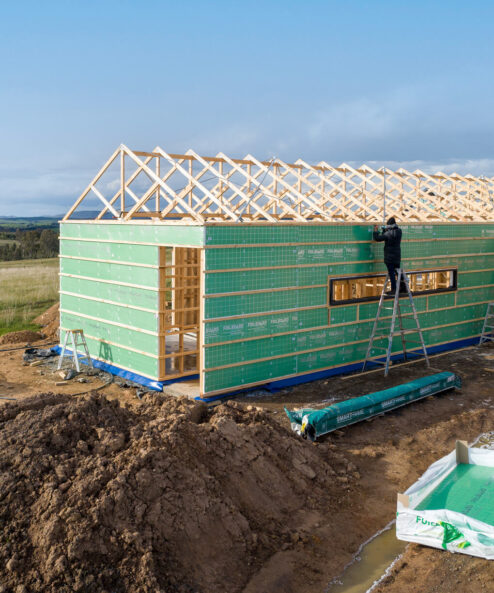
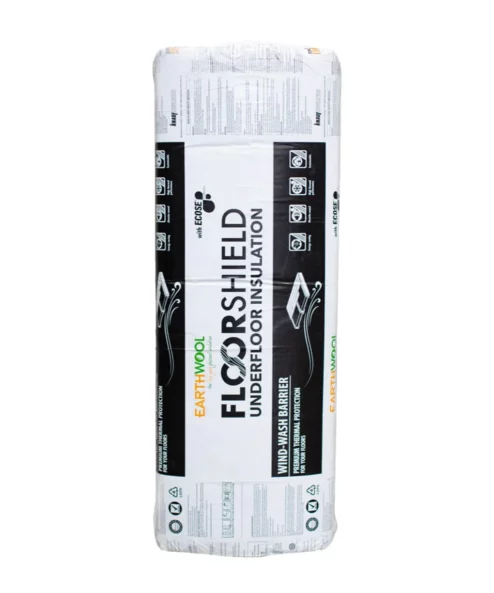
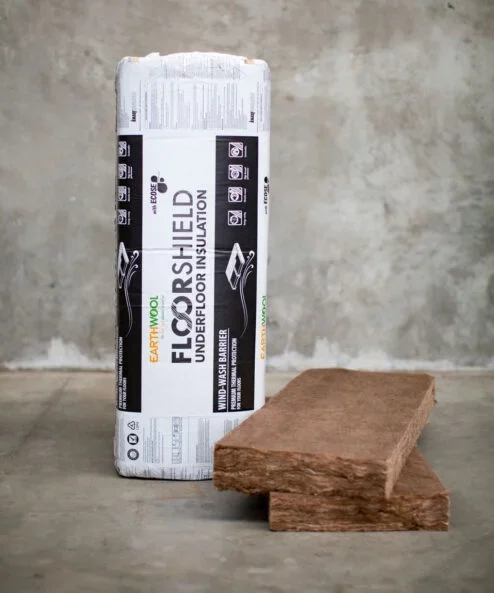
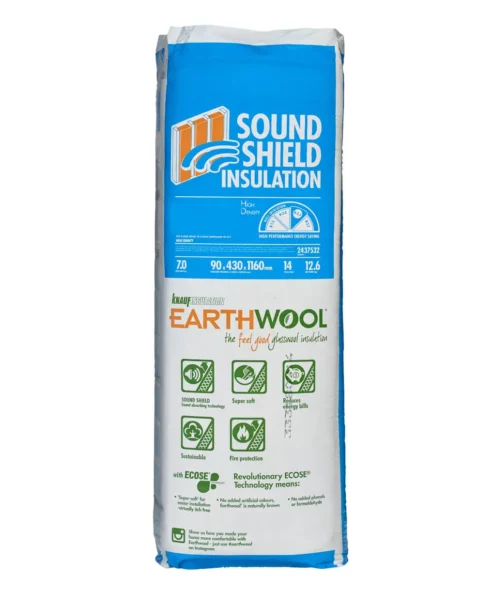
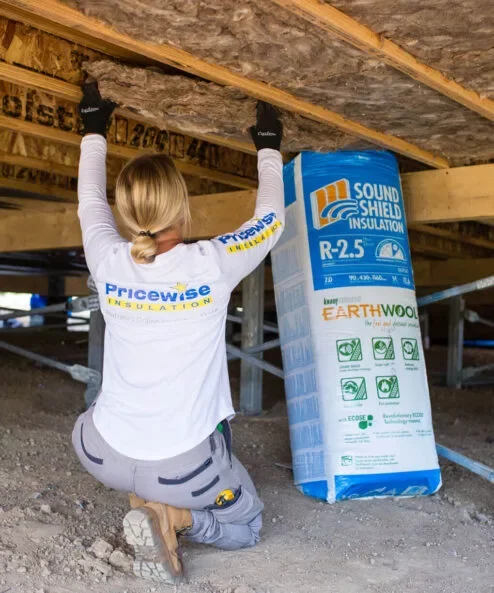
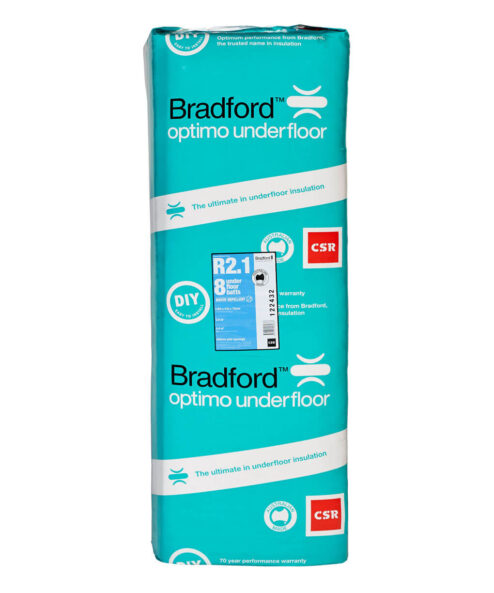
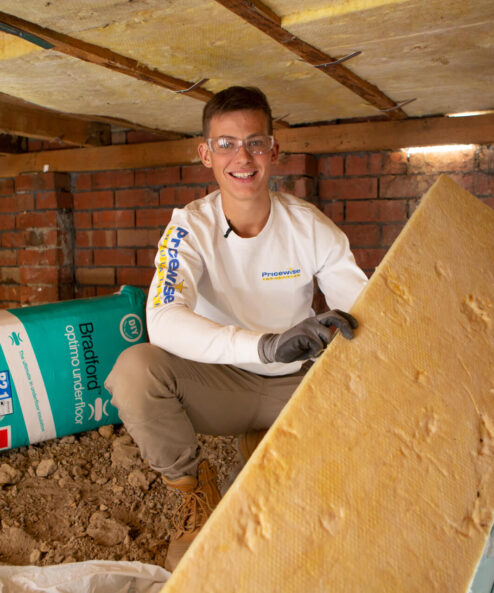
Hi,
I was looking at your underfloor insulation range and would like to know which material you advise. We are living in a fibro house with floor boards and have aprox 1m high underfloor space.
Help would be much appreciated!
Hi Elisha,
Thanks for your question. We would recommend R2.5 Knauf Earthwool Underfloor Insulation, the new Knauf Earthwool Floor Shield Insulationproduct or Autex GreenStuf Polyester Underfloor Insulation (VIC only). The R2.5HD Earthwool Underfloor Insulation Batts are popular among DIY installers because they are cost effective and the batts are rigid, which make them easy to install.
Feel free to give us a call on 1300 729 639 if you have any further questions.
Cheers,
Christa
Hello,
My issue is with moisture coming into the house as the floor is close to the ground in one area. Which insulation would be best? Thank you.
Hi Robyn,
Thank you for your question. We would suggest that you go with a polyester product such as Autex GreenStuf (Available in VIC only) or Bradford Polymax, as these products don’t absorb moisture. Feel free to give our team a call on 1300 729 639 if you have any further questions.
Cheers,
Christa
Hi there,
Wondering what product you recommend? The height of my subfloor varies from approx 250mm to 600mm.
Hi Jono,
Everyone has their own preferences, but I spoke with our insulation specialists and they underfloor insulation rolls for homes with low clearance. Please keep in mind that the areas with a clearance of 250mm will be too hard to access. The only ways to insulate these areas would be if you were to renovate the home and remove the flooring – which is a big process.
– Autex GreenStuf Polyester Underfloor Insulation (Sold in Victoria only).
– Kingpan Air-Cell Permifloor Underfloor Insulation
Feel free to give our team a call on 1300 729 639 if you have any questions.
Cheers,
Christa
Hi, what is the minimum access height you would say to enable installation of underfloor insulation?
Hi Matthew,
Thanks for your question. If your minimum access height is less than 500mm then we would recommend getting the insulation installed by a professional, due to safety reasons with wiring and tight confines etc. Please feel free to give us a call on 1300 729 639 if you have any further questions.
Cheers,
Christa
Generally speaking, you only need to insulate the ground floor. If you’re on an upper floor, you don’t usually need to insulate your floor space.
Hi Matthew,
Thank you for your comment. Insulating the ground floor (underfloor) is important for stopping the transfer of heat between the internal and external areas of the home. Insulating the first floor (between floors) is important for reducing the transfer of noise between levels and creating climate zones within the home. We’ve got an article about this here: Insulation for Between Floors. Feel free to give us a call on 1300 729 639 if you have any further questions.
Cheers,
Christa
Hi there, I have a 130+ year old weather house in Sydney (basically looks like a Queenslander after a second story and balconies were added in the 1950s), which is on piers, with height (in the key areas) ranging from c. 600mm to 1100mm. The issue we have is that gaps open in the (kauri) floorboards (and you can even see the dirt on the ground for some of the cracks). We are keep to cut down the draft and put in insulation, so are wondering whether the insulation itself will eliminate the drafts or whether we need to seal the floorboards from underneath somehow first, before installing the insullation. Thanks!
Hi Tony,
Thanks for your question. Installing underfloor insulation will certainly help reduce draughts and improve the thermal performance of your home. However, we would recommend sealing those gaps first to prevent moisture or dirt from penetrating through the floor and affecting the insulation. If you believe that moisture will be an ongoing issue, then we would recommend installing Bradford Polymax Underfloor Insulation Rolls. These rolls are made from 100% polyester, which means that they won’t absorb any water that comes through the floor when you mop etc. Feel free to give our team a call on 1300 729 639 for a custom quote.
Cheers,
Christa
What is the best insulation that thickness must be 5-10mm max for hybrid flooring.. .. would you let me know pls
Hi Sayuri,
If you only have 5-10mm to work with, then your best option would be to look at a high quality underlay. Obviously these type of products don’t achieve the same thermal performance as slab insulation or underfloor insulation batts, but they are better than nothing. Feel free to give our team a call on 1300 729 639 if you have any further questions.
Cheers,
Christa
Hi,
What is insulation would you recommend for a sub floor? Our house is approximately 60 years old.
I have approximately 350-500mm clearance in most places.
We live in Geelong, VIC.
It’s mostly Harwood flooring above.
Hi Zane,
Thanks for your question. A 350mm – 500mm clearance is quite tight and not suitable for a DIY install, although we do know of professionals that are willing to work in these tight conditions. We would generally recommend installing R2.0 or R2.5 polyester underfloor insulation or R2.5 Knauf Earthwool FloorShield Insulation. If there is a potential for water to seep through the cracks in the hardwood flooring, then we would recommend the polyester option as it does not absorb any water.
Feel free to contact us if you have any further questions.
Cheers,
Christa
The width between our joists ranges from 300mm to 450mm. Can 430mm batts be squeezed in or better to use polyester rolls?
Hi John,
Thanks for your message. Glasswool insulation products such as Knauf Earthwool and Bradford Optimo can easily be cut to size. They come in 450mm widths to suit 430mm joists, but can be cut to 320mm wide to fit 300mm joists. The batts should fit snugly between the underfloor joists so they don’t fall out of place, but they shouldn’t be compressed as this will affect their thermal performance. You can watch our tips on how to install Bradford Optimo Insulation here: https://www.youtube.com/watch?v=HDOA7aiIeOs.
Alternatively, you could purchase 450mm polyester rolls and staple these between the joist as shown in this video: https://www.youtube.com/watch?v=ZzQZ8go0WME. Feel free to give our team a call on 1300 729 639 if you have any further questions.
Cheers,
Christa
Hi, I want to install myself under floor insulation in my weatherboard house with floorboards. There is about 500mm height clearance. Moisture could also be an issue, also which is the best from a sustainability perspective? We live in Melbourne.
Hi Erin,
Thanks for your question. If moisture is a concern then we recommend installing Autex GreenStuf Underfloor Insulation or another polyester insulation product. Unlike glasswool, polyester does not absorb any water.
All Autex GreenStuf products are manufactured using 100% polyester fibre and contain a minimum of 50% previously recycled fibre (from PET plastic). Glasswool insulation products such as Knauf Earthwool are made using recycled glass, so this is not to say that polyester is more sustainable than glasswool.
Given the low clearance of only 500mm, you might want to consider getting a professional insulation installer to assist with the project.
Cheers,
Christa
Hello,
I have a 30 year old house on stumps, recently renovated with new spotted gum floor boards now showing signs of capping from moisture coming up from the ground. I have some under floor fans in place at the moment but am interested in under floor insulation to stop the moisture transfer. Space under bearers varies from 1 meter to 300mm. About 10 percent of the floor area has less than 400mm clearance to the ground. Could you please recommend a suitable product to use, and an installer in the Berwick area, kind regards, Fred Scott
Hi Fred Scott,
Thanks for your comment. If you are having such big moisture issues then we would recommend getting spray foam insulation installed in the underfloor area. We recommend using a closed cell insulation to create a moisture barrier.
There are a couple of companies in Melbourne who install spray foam and it’s a service that EcoHome may offer in the future.
Cheers,
Christa
What R-rating would you recommend for underfloor insulation in Wollongong, NSW?
Thanks!
Hi Pashenka,
Thanks for your comment. We would recommend either R2.0 or R2.5 underfloor insulation in Wollongong, NSW. If you have any further questions then please do not hesitate to send an email to nsw@pricewise.com.au.
Cheers,
Christa
I’m thinking of buying a van home which will be on piers just wondering if
You can lay insulation underneath the floor I’m worried about the cold coming from underneath
Hi Glenda,
We would suggest that you speak with the van home builder for their recommendation.
Cheers,
Christa
We are building a house in Tasmania. It is n stumps, the framing is Bluescope steel with a Yellow tongue subfloor. It is in a BAL 19 bushfire rated area. What is the best insulation do you suggest?
Hi Stuart,
Thanks for your comment. We would recommend any glasswool product for this project. Knauf Earthwool is a good option as it is low-itch, easy to cut and comes in compression packaging for easy handling. It is ideal for DIY install.
Please don’t hesitate to contact our team on 1300 729 639 or via email at sales@pricewise.com.au if you have any further questions.
Kind regards,
Liz
We have an old farmhouse on the Darling Downs in QLD. We have mostly timber floors which get pretty frosty in winter so we were thinking of installing some underfloor insulation ourselves, but don’t know where to start.
Being on a farm we have issues with mice, rats, spiders and snakes. Also one side of the house is fairly high and open where pets and kids can get underneath easily, so I don’t want to use anything that could be damaged by these curious critters or harmful to them.
What would you recommend? Thank you.
Hello Ange,
Thanks for your question. In this instance we would recommend installing Expol Polystyrene Underfloor Insulation between the timber joists. To check stock availability for your remote location, please email sales@pricewise.com.au or call 1300 729 639.
Kind regards,
Christa
I’ve heard about encapsulated batts as another alternative for ease of install. However I can’t seem to find many of these products on Australian sites. Are they allowed for underfloor insulation in Australia?
Hi Mel,
Thanks for your question. Knauf Insulation used to make encapsulated batts, but they have since been discontinued in Australia. Polyester Underfloor Insulation is very similar in terms of the install technique. Depending on where in Australia you live, you could consider Autex Greenstuf Underfloor Insulation, Bradford Polymax Underfloor Insulation or our generic Polyester Insulation Underfloor Rolls.
Feel free to email sales@pricewise.com.au or give us a call on 1300 729 639 if you have any further questions.
Kind regards,
Christa
I am looking for insulation below the floor for a new build. I.e. above the joists and below the yellow tongue. Would like R2 if possible. It will be a steel frame.
Hi William,
For steel frame floors, our recommendation is to install the Bradford Optimo using floor saddles between the floor joints before the installation of the yellow tongue. The unique characteristics of steel frames can pose challenges for some alternative options, although not insurmountable. We have found the Bradford Optimo to be the most straightforward choice for installation in such scenarios.
If you have any further inquiries or need assistance with the installation process, please don’t hesitate to call us on 1300 729 639 or email sales@pricewise.com.au. We’d be happy to assist.
Kind regards,
Felicity
Hello. I see your Polyester Underfloor Insulation comes in R2.0, R2.5, R3.0 and R4.0 options with a $11.52/m2 difference between the R2.5 and R4. I notice also the Bradford and Greenstuff products only go to R2.5. What is the cost : energy saving between your R2.5 and R4.0 products? Are we saving nearly double heat loss, or is it not a linear calculation?
Thanks,
Robert
Hi Robert,
Higher R-values will better reduce heat loss, but it’s not a linear equation. Generally, the additional performance of insulation diminishes as the R-value increases. The R3.0 and R4.0 options were created to meet the higher R-value requirements for floors under the new 7-star minimum energy efficiency standards for new homes.
We have a 100 year old house with suspended kauri pine floorboards. Moisture and rodents/bugs can be a problem in our area. I really like the look of your polyester rolls but worry they would make attractive nesting sites. I am also concerned about sag. What is your recommendation.
Hi Michael,
Thank you for your comment and for providing some background on your home. Polyester insulation is a great choice for underfloor applications because it’s non-irritant, non-toxic, and doesn’t absorb moisture. Unfortunately, rodents are not fussy tenants and will move into any area that is warm and dry. We suggest getting pest control in before installing the insulation.
When installing polyester insulation, you can staple the product to the floor joist (Watch our step-by-step installation video here) We suggest you fasten it every 10 centimeters – this ensures the insulation stays securely fitted over time, even in older homes with suspended floors like yours.
Hope that helps!